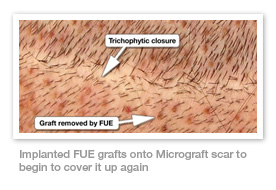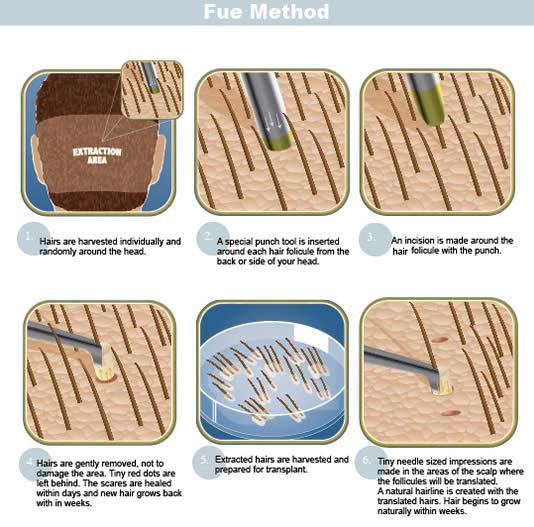editor
FUE Hair Transplant
available at Sure Hair Medical in major cities across Ontario and Toronto at 2115 Finch Ave West, Suite #401, Toronto, ON M3N 2V6

FUE Hair Transplant

Many people may have heard of a relatively new technique in hair transplantation called the FUE method. FUE stands for Follicular Unit Extraction. Basically the “Uni-Strand” ® and FUE are similar in that the doctor and his staff take the hair from the donor area by removing each hair follicle, properly called a follicular unit, one at a time. Each follicular unit is taken out with a small punch. The advantage to this method is that the doctor does not actually have to make a cut in the donor area. The healing is faster and there is no need for stitches. This has led some doctors to say that there is no scar since there is no linear cut.
The FUE technique has been a welcome addition to the hair transplant technology. However, it does have limitations. First of all, it does leave very small scars in the donor area. These scars are usually too small to be seen even with a very short hair cut. Secondly, there can be a high transection rate of the grafts. Many potentially healthy grafts can be lost this way. Also the technique is labor intensive and it can take almost all day just to remove thousands of grafts. It is also more costly than the “Uni-Strand ®” method. For the right patient, with the right needs in good hands, it can be a very valuable technique.
“These follicular units are the anatomical building blocks of how hair is growing in the human scalp. Hair transplantation uses these same follicular units to produce perfectly natural results that are virtually undetectable. Often, not even a close up inspection by your barber, will not give it a way. The hair will grow forever in exactly the same way that it has always grown and you can anything with your new hair that you have always done with your hair.” Dr. Nelson Ferreira

“FUE Hair Transplant” FUE meaning “Follicular Unit extraction”
How it works
In this hair restoration procedure, a 0.7 mm punch is used to make a small circular incision in the skin around the upper part of the follicular unit. The unit is then extracted directly from the scalp.
Because FUE does not leave a linear scar it is used for patients who want to wear their hair very short, less than # 1 on your clippers.
FUE’s main limitation, when compared to “Uni-Strand ®”, is that it is less efficient in harvesting hair from the donor area. We find it is best reserved for patients that do no require large areas to be transplanted or with minimal hair loss requirements.
FUE, in fact, is a type “Uni-Strand ®” where the follicular units are extracted directly from the scalp, rather than being microscopically dissected from a strip that has already been removed. To say it another way, with “Uni-Strand ®”, individual follicular units can be obtained in one of two ways; either through single strip harvesting and stereo microscopic dissection, or through FUE. The finished result where the hair is transplanted will appear identical.
The table below summarizes the pros and cons of Follicular Unit Extraction. Vs. the “Uni-Strand ®” method.
Advantages
- No linear scar. This is important for those who wear their hair very short or who are intending to shave their head from time to time.
- Useful for those with a greater risk of donor scarring.
- Ideal for repairing donor scars that cannot be excised.
- Provides an alternative when the scalp is too tight for a strip incision.
- Enables one to harvest finer hair from the nape of the neck to be used at the hairline or for eyebrows.
- The FUE method makes it possible to harvest non-scalp hair from beard or body hair.
- Most useful when a limited number of grafts are needed.
Disadvantages
- Maximum follicular unit graft yield is lower than with “Uni-Strand ®” method. This is due to the inability to harvest all the hair from the mid-permanent zone.
- The scarring and distortion of the donor scalp from FUE makes subsequent FUE sessions more difficult.
- Greater follicular transection (damage) compared to “Uni-Strand ®”
- Greater patient variability in those who are good candidates compared to “Uni-Strand ®”
- More difficult to capture the entire follicular unit.
- More difficult to obtain a natural distribution of follicular units.
- For efficiency, the largest follicular units are targeted, but these may not be ideal for the hairline.
- Grafts are more fragile and subject to trauma during placing since they often lack the protective dermis and fat of microscopically dissected grafts.
- Microscopic dissection may still be needed if the number of single-hair grafts is inadequate to remove hair fragments
- Grafts harvested from outside the donor area will not be permanent.
- After large numbers of grafts are harvested, fine stippled scars may become visible due to thinning of donor area.
- Size of session is limited.
- Requires multiple sessions to equal the size of a single “Uni-Strand ®” session. FUE also takes longer to perform.
- More expensive than “Uni-Strand ®” session
- Possibility that problems could occur with buried grafts. This happens during the blunt phase of the three-step technique. When the graft is pushed into fat and must be removed through a small incision
After many years of extensive research, observation and training Dr. Ferreira joined Sure Hair International as the medical director in 2005. Sure Hair International had been performing follicular unit hair transplants since 1996. Dr. Ferreira wrote and published this article with the hopes that our potential clients will better understand the emerging techniques involved in hair transplant.
A letter from Sure Hair Medical Directoru
November 18 2010
A Few words about FUE
The technology in the hair transplant field has come along way especially in the last 15 years. The discovery of naturally occurring follicular units, and the ability to use a microscope to dissect hair into follicular units means that a hair transplant can be virtually 100% natural.
The most established follicular unit technology is the strip method. In the strip method, a strip of skin is taken from the back and sides of the head and then dissected into follicular units (grafts) and then placed into the thinning area into small holes. In experienced hands, the results can be spectacular. However, in a small percentage of cases the door scar did not heal well or widened. This led to the idea of transplanting hair into the scar to make it less obvious. The hair was harvested from the back and sides of the head one at a time by using a small punch biopsy so that it would not leave behind a very visible scar. This was the birth of the FUE (follicular unit extraction).
Initially the FUE was designed for small cases where only a few grafts were needed. With the FUE method you cannot see the root of the grafts until it is pulled out of the head. As a result, traditionally there is a high rate of transection which means the root of the follicle is cut and will not grow. This was considered acceptable since only a small number of grafts were needed. Since the FUE method leaves very small scars that are very hard to see, many doctors started promoting the FUE method as an alternative to the strip method.
The FUE has been promoted as a “scarless” surgery. This is not true. It is true that often the scars are so small that a patient can wear the hair very short. The technology for the FUE has evolved and now there are powered drills that help take out larger number of grafts in a more efficient manner. However, for reasons we do not understand, sometimes even when large number of “good ” FUE grafts are planted in a FUE transplant, many will not grow. I am sure that with time the technology will improve.
A word of caution about the FUE. It does leave a scar. If a hair transplant is done using 2000 grafts for example, then the patient will be left with 2000 little scars. This may not be a problem the first time. However, if a patient needs a second transplant with 2000 grafts, then he will have a total of 4000 little scars at the back of his head. This can leave the patient with a “swiss cheese“ look. Furthermore, it becomes more and more difficult to find “good grafts” amongst the scarring in the donor area when the FUE is used. Typically with the strip method one scar is all that is produced no matter how many surgeries.
Recently, a news show showed a new machine that takes out follicular units automatically using the FUE method. This new machine was marketed as being the “latest breakthrough” in hair transplant technology. In fact, the machine has been around for many years and was not considered a reliable method of doing the FUE. I know for fact that the company who makes the machine has improved the technology and that it is now at the 7th generation with the device. This is good news. Myself and other hair transplant doctors are waiting to see how well the machine performs before considering routinely using such as a device.
However, it seems that some doctors are now purchasing the new machine with the intent of performing hair transplants when they have little or no experience performing hair transplants. A hair transplant is a very delicate procedure that takes an entire team of people to perform. It takes a lot of practice and experience to do a good hair transplant.
There are many reputable hair transplant doctors who feel that it is not appropriate for non-experienced doctors to jump on the bandwagon and perform hair transplants because “the machine will do all the work”. If a machine could perform all the technical aspects of a hair transplant, you still need a doctor to plan and design the transplant. You can’t just put hair anywhere! You need to plan for future hair loss. A doctor needs to have the artistic skills produce a natural hairline and understand donor recipient ratios and density gradients. Think of it this way: there are air guns that will put nails into wood boards very quickly and efficiently. However, you wouldn’t let a machine build your house – you still need a contractor who knows how to build a house!
There is a time and a situation where any technology will serve you well. Make SURE you speak to an experienced professional who can offer the right technique for you!
*Additionally you can visit the International Hair Restoration Surgery website (www.ishrs.org) and read their position paper on the FUE method.
Medical Director, Sure Hair International
the above reprinted with permission from Sure Hair
sponsor of Hairsite at the time of publication

